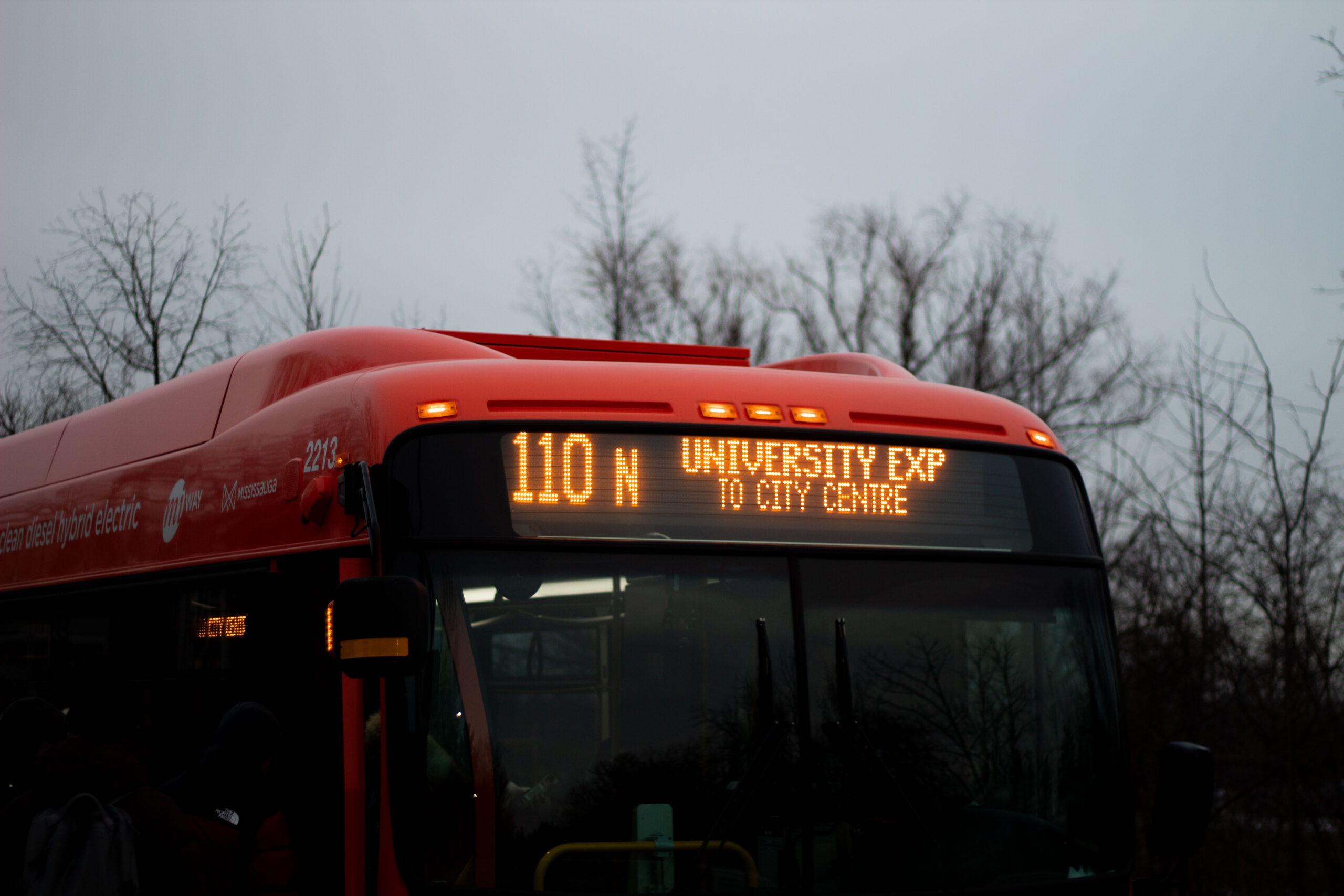MiWay is out to ruin my life
The hyper-specific inconveniences that MiWay sets out for its travellers make it seem like it’s targeting UTM’s commuter students.
I love studying at the University of Toronto Mississauga (UTM). I love my program, and I’m grateful to be surrounded by smart, hard-working individuals and taught by extremely talented, intelligent professors. Occasionally, as I wait for my classes in IB to start, my breath is suddenly taken away as I ponder the privilege that allowed me to come here, as well as all the opportunities that have come my way ever since. However, one barrier has consistently stood in the way of me getting my degree. That barrier is MiWay.
From the get-go, MiWay and I were at odds. I began attending UTM in September 2021, when almost all classes were still online. Halfway through the academic year, we were informed that we would be moving back to in-person. Mere days after this announcement—and mere weeks before the transition was set to take place—MiWay cancelled my bus. I’m not talking about a reduced schedule or the random disappearance of a single bus that was supposed to show up half an hour ago (although that has happened plenty of times since then). MiWay removed the route—the 110, or so-called “University Express”—completely and indefinitely.
The decision sparked widespread outrage among UTM students. We started and signed a petition, which I also sent to my extended family and entire friend group. We made it to the news. MiWay reinstituted the route, and it was running again by the time I returned to campus. I tried to put aside my outrage and replace it with relief and gratitude.
That resolution was beaten out of me. During my first in-person term at UTM, there were 24 instances in which the drivers of the 110N bus were already pulling away by the time I got off the GO train and headed down to the terminal (that’s an average of three-ish times per week). This was because my train was scheduled to arrive at the station at 8:22 a.m., and the bus was scheduled to leave the station at 8:24 a.m. Often, the drivers treated this schedule as a gentle suggestion, and I could already see the bus driving away before my train even stopped.
I developed a habit of getting on at the very last car of the train, being the first to get out of my seat and stand in front of the door, and then absolutely booking it across the platform, down the stairs, through the ticket office, and across the terminal the moment the GO train doors opened. The lady who drove the 8:24 bus on Fridays became so used to the sight of me frantically (and ungracefully) sprinting that she started waiting for me before she left. She is my only positive MiWay story. I hope she’s doing well right now wherever she is.
Because the buses were 15 minutes apart and the trains were 30 minutes apart, I was basically guaranteed to miss the next bus regardless of which train I took. At the time, it was an infuriating but minor inconvenience, since the next bus would arrive shortly thereafter, and I would still be on time for my classes.
This trend continues throughout my second year, with a few additions. Now, the bus that I take back to Clarkson GO after my classes, the 110S, is scheduled to arrive at the GO station two minutes before my train leaves.
Infinite is the number of times said bus arrives on campus five or more minutes late. Infinite is the number of times the bus is on time, but the driver completely disappears for a bathroom break or smoke break and doesn’t return to the bus until four minutes after we were supposed to leave. At least three times MiWay has caused me to miss the train by only a few seconds and then the next train gets cancelled, leaving me to wait at Clarkson GO for a full hour.
There have been two times when the bus is more than five minutes early and, as I run to catch it, the driver looks me in the eyes, closes the door in my face, and drives away. The first time this happens, I throw my bag on the ground and exclaim in distress. The second time, I cry. The other students gathered at the stop look at me with deep sympathy. I bond with complete strangers over the injustice of it all.
I can—and do—blame the drivers, but I also blame MiWay for making a schedule that’s so awful in the first place.
MiWay, I tell my friends, is targeting me specifically. I tell them that MiWay hates me and is actively sabotaging my degree. I tell them that they’re designing their schedule so that I can never get to campus and never return home. They laugh at me. They don’t believe me. MiWay is not only threatening my degree but isolating me from my friends. My sanity begins to unravel.
Cue third year. The 110N is now scheduled to leave Clarkson GO two minutes before my train arrives. Additionally, there are now only three buses per hour, departing 20 minutes apart.
On my first day of class, I have a 9 a.m. lecture. I arrived at Clarkson at 8:23 a.m., obviously missing the bus that left at 8:21 a.m. I wait for the next one. When it comes, the driver leaves for a bathroom break and doesn’t return until 8:48. After we finally depart, we are stuck at the intersection of Dundas Street and Mississauga Road for 20 minutes because it has never occurred to MiWay that they could increase the number of buses they send during rush hours. This is because, even on a route called the University Express, their dedication to getting students to the university is hilariously lacking.
“It is not my job to make sure you get to school on time and within your convenience!” MiWay executives taunt me in my sleep. Um, yes, it is. That’s the function of public transit.
UTM is 5.3 kilometres—an 8-minute drive—away from Clarkson GO. Despite arriving at Clarkson at 8:23 a.m., I don’t get to campus until 9:15 a.m. I am more than 10 minutes late for the first lecture of the year. I rush in sweaty and disgruntled and sit alone in the back.
It is especially hilarious that the students who suffer the most from these ill-planned schedules are GO train riders who already have extensive commutes. Mine, for example, is 1 hour and 18 minutes long. To put it another way: it takes 1 hour and 18 minutes for me to commute across the entirety of the GTA—from the border of Pickering to the heart of Mississauga—and 52 minutes to travel 5 km in Mississauga. That is obscene.
The U-Pass is supposed to reduce the financial cost of transit, but it’s impossible to get anyone to care about the emotional and mental toll of getting anywhere in the city, even your campus. Complaints to the university about MiWay receive responses about how it is the University of Toronto Mississauga Students’ Union (UTMSU) that facilitates the distribution of U-Passes. Complaints to the UTMSU about MiWay receive responses that they don’t control the way the buses are scheduled. Even though MiWay receives part of our money every time we pay the school, student voices don’t matter to them. They have no desire to make students’ lives easier. If anything, they make our lives unnecessarily difficult.
I used to joke that, by the time I got to campus at 9 a.m., I’d already felt like I’d accomplished something by commuting there. Now, I realize that’s messed up and things are not supposed to be that way.
Copy Editor (Volume 50); Associate Arts & Entertainment Editor (Volume 49) — Maja Ting is in her third year at UTM, completing a Specialist degree in Forensic Biology. In her spare time, she reads, visits the ROM repeatedly, waits for public transit, talks and reckons more than is good for her, and refers to herself in the third person.


